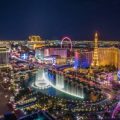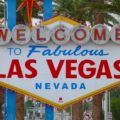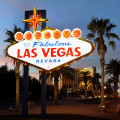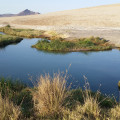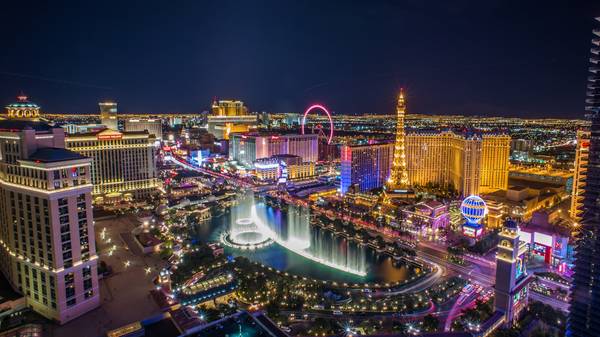
Short Story Covering the History of Las Vegas
Sands of Fortune: The Rise of Las Vegas
Outline:
- Introduction
- The allure of Las Vegas: Why it captures imaginations worldwide.
- The transformation from a desert stopover to the Entertainment Capital of the World.
- Before the Neon Lights: Early History (Pre-1900)
- The Mojave Desert and its early inhabitants.
- Spanish explorers and the Old Spanish Trail.
- Railways and Establishment (1900s – 1920s)
- The establishment of Las Vegas as a railroad town.
- Water sources: The importance of springs and later, the Hoover Dam.
- City of Sin: The Mob Era (1930s – 1960s)
- The legalization of gambling and the birth of the Strip.
- The influence of organized crime and notable figures like Bugsy Siegel.
- Stardust, The Flamingo, and other iconic establishments.
- Shifting Sands: The Corporate Takeover (1970s – 2000s)
- The decline of mob influence and the rise of corporations.
- The mega-resorts: Mirage, Bellagio, and others.
- The evolution of entertainment: From Rat Pack to Cirque du Soleil.
- Modern Las Vegas (2000s – Present)
- Expansion beyond gambling: Dining, conventions, and family-friendly attractions.
- The challenges faced: Economic downturns, competition from global destinations, and the pandemic.
- The ever-changing skyline: Newer establishments and the quest for novelty.
- Cultural Impact and Beyond the Strip
- Las Vegas in popular culture: Films, songs, and literature.
- Downtown Las Vegas, Fremont Street, and the arts district.
- The importance of local communities and the broader impact on Nevada.
- Conclusion
- The enduring allure and future challenges.
- Las Vegas as a symbol of American aspiration, indulgence, and resilience.
1. Introduction
The Allure of Las Vegas:
Las Vegas, aptly named ‘The Entertainment Capital of the World’, is a city that has mystified and attracted millions. At its core, Vegas offers the allure of escapism. It promises an oasis where everyday rules are suspended, and fortunes can change with the roll of a dice. Over the years, this shimmering mirage in the middle of the Mojave Desert has been depicted in countless movies, songs, and books, creating a magnetic pull for dreamers, gamblers, and thrill-seekers.
The Transformation from Desert Stopover to Global Attraction:
Long before the blinding neon lights and the cacophony of slot machines, Las Vegas was but a modest water stopover. Its transformation is a testament to human ambition and a relentless desire to tame even the most inhospitable environments. From its roots as a railroad town to its reputation as a mobster’s playground, and finally its rebirth as a corporate-powered global destination, the history of Las Vegas is as fascinating as it is tumultuous.
2. Before the Neon Lights: Early History (Pre-1900)
The Mojave Desert and its Early Inhabitants:
Las Vegas Valley was home to indigenous peoples long before Spanish explorers set foot there. The Ancestral Puebloans and Paiute tribes thrived in this arid environment, relying on the few springs in the area for sustenance. Artifacts and petroglyphs, which can still be seen at places like the Red Rock Canyon, tell tales of their intricate societies and their connection to the land.
Spanish Explorers and the Old Spanish Trail:
The first European contact with the area was in the 19th century when Spanish explorers, including Rafael Rivera, scouted the region. The name “Las Vegas” (The Meadows) was coined because of the area’s fertile fields, nourished by the springs, a rarity in the desert. The Old Spanish Trail, a trade route that connected New Mexico to California, ran through the Las Vegas Valley, making it a vital stopover point.
3. Railways and Establishment (1900s – 1920s)
The Establishment as a Railroad Town:
In the early 20th century, Las Vegas found its footing as a railroad town. The San Pedro, Los Angeles, and Salt Lake Railroad, spearheaded by Senator William Clark, linked Southern California to Salt Lake City and ran directly through Las Vegas. In 1905, a land auction marked the establishment of Las Vegas as a city. The booming railroad activity transformed this desert stopover into a blossoming commercial hub.
Water Sources – Springs to Hoover Dam:
Water has always been vital for Las Vegas. Early settlers relied on the springs, but as the city grew, the need for a stable water supply became paramount. This need culminated in the construction of the Hoover Dam in the 1930s, a mammoth engineering marvel. The dam didn’t just provide water; it also generated electricity, and its reservoir, Lake Mead, became a recreation hotspot.
4. City of Sin: The Mob Era (1930s – 1960s)
Legalization of Gambling & The Birth of the Strip:
1931 was a pivotal year: Nevada legalized gambling, offering a legitimate face to what was already an underground operation. As a result, the Las Vegas Strip was born. While the first casino-resort, El Rancho Vegas, was established in 1941, it was the Flamingo, financed by mobster Bugsy Siegel, that set the template for future resorts: luxury accommodations, top-notch entertainment, and sprawling casinos.
Organized Crime and the Stardust Saga:
While Siegel’s Flamingo venture initially tanked, leading to his mysterious assassination, it paved the way for other mob-controlled casinos. The Stardust, in particular, became infamous for its connections to organized crime, serving as a cash cow for the Mob for decades.
5. Shifting Sands: The Corporate Takeover (1970s – 2000s)
Decline of the Mob and Rise of Corporations:
The 1970s and 80s saw a significant shift. With increased FBI scrutiny, the mob’s influence waned, and corporations began taking over. Visionaries like Steve Wynn ushered in a new era, where the emphasis shifted from mere gambling halls to luxurious mega-resorts.
The Mega Resorts Era:
The Mirage, which opened its doors in 1989, set the trend with its opulent design and high-end entertainment. It was soon followed by resorts like the Bellagio, Mandalay Bay, and the Venetian, each trying to outdo the other in luxury and grandeur.
6. Modern Las Vegas (2000s – Present)
Beyond Gambling – Diverse Entertainment:
The new millennium saw Vegas expanding its offerings. Cirque du Soleil shows, world-class dining, conventions, shopping centers, and even family-friendly attractions became integral to the Vegas experience.
Economic Challenges and Evolution:
The 2008 economic downturn hit Las Vegas hard, with tourism dwindling and many projects halted. However, the city, known for its resilience, bounced back, continuing to reinvent itself and remaining a global entertainment hub.
7. Cultural Impact and Beyond the Strip
Vegas in Popular Culture:
From Elvis Presley’s “Viva Las Vegas” to movies like “Ocean’s Eleven” and “The Hangover”, Las Vegas’s portrayal in pop culture has been instrumental in shaping its image worldwide.
Downtown Las Vegas and the Arts District:
Beyond the Strip lies Downtown Vegas, with its historic Fremont Street, and the Arts District, showcasing local artists and quirky boutiques—a testament to Vegas’s cultural depth beyond glitz and gambling.
8. Conclusion
Las Vegas’s history is one of transformation and resilience. From a desert watering hole to a mobster’s paradise, and then to a corporate behemoth, its journey reflects broader American trends and the spirit of relentless reinvention.

